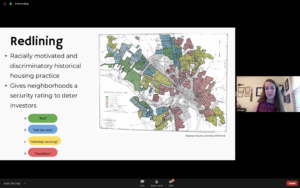
Senior Allison Grant explains how climate change has disproportionately affected redlined communities, a project she’s worked on under the guidance of Assistant Professor of Earth and Environmental Science Pamela Grothe. Grant was one of 19 UMW students who presented their research yesterday over Zoom as part of Mary Washington’s Summer Science Symposium.
Temperatures soared yesterday, but Allison Grant was cool and calm as she explained how climate change has disproportionately affected low income neighborhoods that are impacted to a greater degree by heat.
“Redlining was outlawed over 50 years ago,” said the UMW senior, citing the discriminatory lending practice that prevented minorities from purchasing homes. “Yet it continues to have a damaging impact on current communities, especially African Americans.”
Grant was among the 19 students who participated in the University of Mary Washington’s Summer Science Institute (SSI), which engages undergraduates in an intense 10-week research experience – in collaboration with their professors and peers – and provides a jumpstart on projects they’ll continue throughout the school year. The SSI Research Symposium, held virtually over Zoom for the first time, gave these young scientists the chance to explain their methods and findings to a wider audience.
Students from six concentrations – biology, chemistry, Earth and environmental science, computer science, mathematics and physics – displayed giant posters and delivered oral presentations. They discussed real world topics, from the reduction of carbon emissions during the COVID-19 pandemic and the use of statistical models to predict weather patterns, to pollinator insect diversity and more effective ways for computers to multitask.
“SSI is about providing an authentic research experience, and we’re fortunate that we can continue to give this to our students,” said Associate Professor of Chemistry Davis Oldham, who coordinated this year’s program with Assistant Professor of Mathematics Jeb Collins. “They’re still learning new skills, receiving faculty feedback and getting opportunities they could not get in a classroom setting.” Read more.



